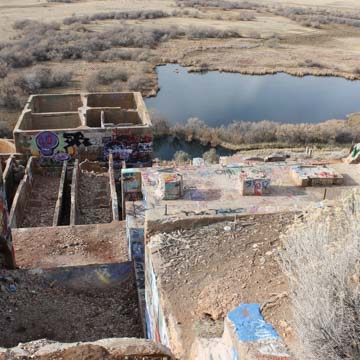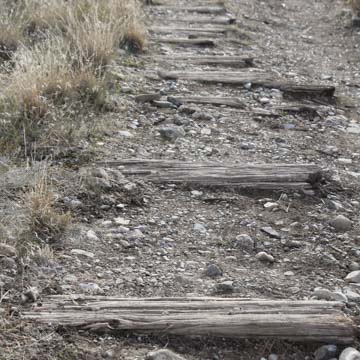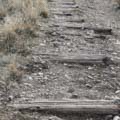The Tintic Standard Reduction Mill is a ghostly remnant of the gold rush activity that transformed Utah’s economy, demographics, and infrastructure between 1869 and 1940. Mormon leaders had initially resisted the industry, believing the quick profits would have a negative moral impact. But as soon as the transcontinental railroad was completed in 1869, Mormon resistance to precious metal mining waned. Mormons soon dominated the industry and many church leaders, including John Taylor, George Q. Cannon, and Joseph F. Smith, owned silver mines.
During this period, the compact region of Tintic in central Utah yielded some half-billion dollars in gold and silver. The mill was designed and built between 1918 and 1919, two years after the Tintic Standard Mining Company (established in 1907) struck rich ore in a mine a mile and half away in a town called Dividend. In February 1916, a month before the announcement of the discovery, the stock of the company sold at 2.25 cents; in November 1918, it had shot to $15 a share. Company founder Emil Raddatz commissioned one of the most prominent mechanical and metallurgical engineers in Salt Lake City to design the mill; William C. Madge had previously supervised the construction of numerous smelting plants as a chief engineer for the Yampa Smelting Company and Mason Valley Miners Company.
Madge chose a steep site just above Goshen’s warm water spring, just a few paces from the railway line. He used gravity to process the ore, which arrived at the top of the hill via railroad tracks. As one walks through the site today, traces of railroad ties and rail lines appear and disappear under thick rubble, sagebrush, and red-orange rock. The rail spur traveled north to connect to the nearby main line. The mill employed the Augustin process, which used salt and other chemicals to separate the sulfide and other waste rock from the silver. The mill’s recovery rates were quite high; in 1924, the mill extracted 85 percent of the silver, 60 percent copper, 32 percent lead, and 7 percent of the gold held in the ore. Madge arranged the plant on the most logical method of progression, with raw material passing gradually downwards from process to process until it left the refinery in its finished state.
The Tintic Standard Reduction Mill was built at a cost of $580,000. The Augustin process was effective but costly, and by 1924 it was obsolete. In addition, the mill could not keep up with the supply. It received ore from three company mines but could only process half of it. Though the mill operated around the clock, none of the workers lived there. The company built bunkhouses in a nearby town called Harold (named after Rattatz’s son). The mill’s activity was short-lived, closing down just four years after it opened. Both the mill and the company town have since been abandoned, although the Tintic Standard Mining Company retained ownership of the mill property until the 1970s, when it was sold to Amax Arizona Inc.
In 1974, the Historic American Engineering Record (HAER), together with a number of local partners in Utah, prepared measured drawings of the site. Historic photographs show that, in addition to the mill itself, there were also several wooden shacks and sheds on the site, as well as bridges, walkways, trails, and electrical poles. Today, all that remains are rows of squat cylinders and rectangular chambers protruding out of a steep rock. These were originally enclosed in a wooden megastructure marked by a fat concrete chimney and slender iron flues. With the structure dismantled, the cylinders, tapering preceptors, and the drain boxes are exposed to the elements. The series of stepped sloping roofs with continuous clerestories have all disappeared. The Utah Division of Wildlife Resources took ownership of the 280-acre site in 1986. The Department of Environmental Quality tested water and soil samples in 2002, and found high levels of arsenic and lead. The area has since been closed off to the public, but the Tintic Mill continues to draw its fair share of graffiti artists.























